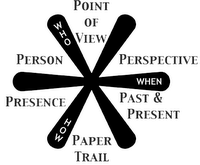Writing Advice That Goes Deep
Earlier this month the Editorrent blog discussed the challenges of “Deep POV”, explaining:
Deep POV is a variety of single POV, where an entire scene (or chapter, or book) is told through the perspective (or point of view) of one of the characters in the scene. Deep POV takes this further—the narration is done not just in the perspective but in the voice of the POV character. It’s meant to establish almost no distance between the narrator and the reader—rather like a first-person feel with third-person pronouns.I hadn’t come across this term, and Google Books hadn’t picked up on it, either, so I figured it’s relatively recent. Indeed, it appears to be a coinage of author Suzanne Brockmann, who explained it this way in a 2005 interview with Writers Write:
Deep Point of View was a phrase that I came up with when I was trying to explain my writing style. Point of view can be subjective (picture a hand-held camera on top of a character’s head) or objective (picture something like a security camera, bolted into place in the corner of a room).Brockmann works in the romance genre, and no doubt as a result most of the other websites discussing “deep POV” are also focused on romance. Editorrent’s write-up suggests a lot of writers are trying it, not all successfully. But there are no doubt examples from other types of novels as well.
In my books, I use subjective point of view, but I’m not satisfied with merely showing the reader what that camera sees from its perch atop a character’s head. I bring the camera down, inside of that character’s head, so we see the world through that character’s eyes. We hear things through his ears. We smell what he smells, feel what he feels, think what he think. With deep POV, I write using words that that character would use. I tell the story with that character’s voice.
Deep POV is very similar to writing first person. (I, me, mine...) Except it’s third person. (Sam’s, He, him, his...) When I use deep POV (which is pretty much all the time!), I don’t need to write “he thought,” or “he felt”—it’s understood that the words I’m writing are this character’s thoughts and feelings. This makes for tighter pacing and a livelier voice.
 But what I really cared about was how this approach to narration fits into my “Six Parameters of Narrative Voice.” Does it require a new parameter? Which would be a bother since I’ve run out of P-words to label them.
But what I really cared about was how this approach to narration fits into my “Six Parameters of Narrative Voice.” Does it require a new parameter? Which would be a bother since I’ve run out of P-words to label them.But I decided that deep POV fits in just fine; it’s just a relatively uncommon combination of these parameters:
- Point of View, which we can define through that camera analogy as well as anything else: Tight single.
- Person, a grammatical measure: Third.
- Perspective, my term for the amount of time that passes between events and narration: Immediate, totally in the moment.
- Past and Present, another grammatical choice: Either.
- Presence of author: None at all.
- Paper Trail, or the presentation of the story through documentary forms: None.


2 comments:
i've always understood that the three main points of view (first-, second-, and third-) had degrees of distance, i.e. close (limited) or distant (reflective). "deep" sounds like another definition of close to me.
i can't find it right now, but this come from john gardner. the distance is determined by how close to the events the narrator is telling them - did they just happen (in which case they would be close and fresh but lacking depth of analysis) or are they distant (having taken place in the past and are being told with a degree of reflection appropriate to the story).
i haven't read brockman's book, but it sounds like she's writing from a (very) close first person, which can be tricky because writing a character "in the moment" means the reader has to make connections at the same speed as the narrator, and the narration cannot see beyond the what's directly in front of them.
this is the first i've heard the term deep used. perhaps my pov has been limited.
I found a website from the Open Fiction Project that discusses narrative point of view with ideas that overlap yours and mine. Unfortunately, different people use different terms for the same things, or the same terms for different things.
For instance, this webpage uses “audibility” for the quality I call “presence.” John Gardner coined “psychic distance” for what I call (though only in temporal terms, not necessarily psychological) “perspective.”
The website author uses “perspective” to mean what I would treat as common combinations of Point of View, Perspective, and Presence.
I tried to break out those parameters separately because I think there are more possibilities than the six listed there: Limited, Multiple, Subjective, Objective, Omniscient, and Reminiscient.
For instance, the website says, “First person narration is Limited by definition.” But what about From the Mixed-Up Files of Mrs. Basil E. Frankwiler or The Book Thief or Madame Bovary? They aren’t “strictly limited to the internal world, thoughts and observations of one character.”
I bet you’re right that “close” and “deep” are pretty much synonyms here, except that in “deep POV” Brockmann is not writing in the first person grammatically, but is writing very “close” to one character’s immediate experience in every other way.
Post a Comment